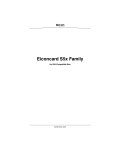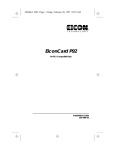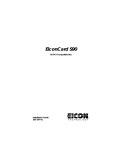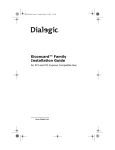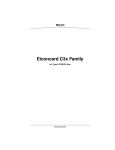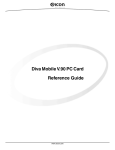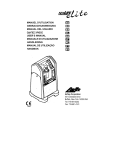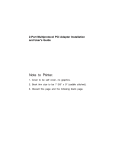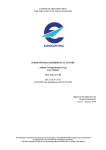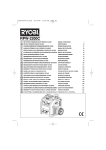Download Eicon Networks ISDN NT1 Specifications
Transcript
Eiconcard S9x Family for PCI-Compatible Bus www.eicon.com First Edition (July 2001) 203-227-01 Eicon, Eiconcard, and the Eicon logo are either trademarks or registered trademarks of Eicon Networks Corporation. Changes are periodically made to the information herein; these changes will be incorporated into new editions of the publication. Eicon Networks may make improvements and/or changes in the products and/or programs described in this publication at any time. Copyright © 1996-2001 Eicon Networks Corporation. All rights reserved, including those to reproduce this publication or parts thereof in any form without permission in writing from Eicon Networks Corporation. www.eicon.com Table of Contents Introduction ................................................................... 5 About this Manual ....................................................................... 6 Installing the Eiconcard S9x.......................................... 7 Making an ISDN Connection......................................... 9 Eiconcard S91 S/T...................................................................... 9 Eiconcard S91 U....................................................................... 12 Making a VHSI Connection ......................................... 13 Interface Specifications ............................................... 14 Cable Construction Information ................................................ The V.24 DCE Interface ............................................................ The V.24 DTE Interface ............................................................ The V.35 Interface..................................................................... The EIA-530 Interface............................................................... The V.36/RS-449 Interface ....................................................... The X.21 Interface .................................................................... Back-to-Back Connections ....................................................... 15 16 18 20 22 24 26 28 LED Functionality ........................................................ 29 Technical Specifications.............................................. 31 International Regulatory Information ........................... 33 www.eicon.com www.eicon.com Introduction The S9x family of Eiconcards are PCI Plug-and-Play (PnP) cards that offer X.25 connectivity through one or two (depending on the the Eiconcard model)very high-speed ports (supporting V.24, V.35, EIA-530, V.36/RS-449, or X.21 interfaces) at speeds of up to 2 Mbps, and/or through an ISDN BRI port (Eiconcard S91) at speeds of up to 128 kbps (over the “D” channel or the “B” channels). Note The Eiconcard S9x also supports protocols such as SDLC, PPP, and Frame Relay. All Eiconcards have been tested and found to comply with the Electromagnetic compatibility, Safety and Network connection regulations within the European Union, North America, and other major territories. Read the regulatory information on page 33 before installing and using your adapter. Hardware Features The Eiconcard S9x features the following: Eiconcard CPU/Memory/Flash Eiconcard S90 25 MHz Motorola 68302 / 1 MB RAM / 1 MB Flash # of VHSI Ports #of ISDN BRI Ports 1 N/A Eiconcard S91 25 MHz Motorola 68302 / 1 MB RAM / 1 MB Flash 1 1 Eiconcard S92 33 MHz Motorola 68360 / 1 MB RAM / 1 MB FLASH 2 N/A Eiconcard S94 33 MHz Motorola 68360 / 8 MB RAM / 1 MB FLASH 2 N/A The Very High-Speed Interface (VHSI) ports, support full duplex communications over a V.24, V.35, EIA-530, V.36/RS-449, or X.21 interface at speeds of up to 2 Mbps per port (depending on the type of interface selected). The ISDN BRI port supports transfer rates of up to 128 kbps (over the “D” channel or the “B” channels). Ease of Use The VHSI port features automatic interface selection. The intelligent controller on the Eiconcard S9x detects the type of cable connected to the port and automatically selects the matching interface. Introduction 5 Installing the Eiconcard S9x Follow the steps below to install the Eiconcard S9x. If you want the Eiconcard S9x to be available to multiple users on a LAN, install it in the PC that will function as a gateway for the LAN. 1 Prepare the PC Turn off the PC and disconnect its power cable. Remove the cover of the PC according to the instructions that came with it. 2 Install the Eiconcard S9x Drain static electricity from your body by touching the metal chassis (the unpainted metal at the back of your PC). b) Locate a slot in your PC that has the same bus type as your adapter. If your PC has both ISA and PCI slots, the PCI slots are shorter, as shown. a) metal plates PCI slots ISA slots Figure 1. Locating a PCI slot If there is a metal plate at the end of the slot, remove it and keep the screw. d) Firmly insert the adapter into the selected slot. To avoid damaging your hardware, insert the adapter only into a slot with the same bus type as the adapter. Inserting the adapter into any other type of slot can damage your adapter, your PC, or both. c) 6 Installing the Eiconcard S9x screw PCI Eiconcard PCI slot Figure 2. Inserting the Eiconcard S9x. Fasten the adapter with the screw (to ensure that the adapter is properly secured and grounded to the PC’s chassis). f) Replace the cover of your PC as described in your PC’s manual. g) Reconnect the power cable. e) 3 Test the Eiconcard S9x The application software purchased with the Eiconcard S9x contains a test program to verify the card’s integrity. Consult the documentation supplied with this software for details. 4 Configure the Eiconcard S9x Before you can use the Eiconcard S9x, you must configure it to work with your communications software. The documentation which came with this software contains complete instructions on how to configure the card. For information on the LED functionality, see “LED Functionality” on page 29. 5 Connect to the outside world You are now ready to connect the Eiconcard S9x to the outside world. • To set up ISDN connections, consult “Making an ISDN Connection” on page 8. • To set up a VHSI connection, consult “Making a VHSI Connection” on page 13. Installing the Eiconcard S9x 7 Making an ISDN Connection Note Only the Eiconcard S91 supports ISDN connections. After you have installed your Eiconcard S91, connect your ISDN line. In Europe and most countries worldwide In Europe as well as most countries outside of North America and Japan, your Eiconcard S91 adapter can be connected directly to your ISDN line using the included cable. 1. ISDN wall jack Eiconcard S91 3. 2. Figure 3. Connecting the ISDN cable. 1 Take the cable included with the Eiconcard S91. 2 Plug one end into the Eiconcard S91. 3 Plug the other end into the ISDN wall jack. In North America and Others In North America and some other countries (check with your ISDN provider), you need an NT1 (network terminating device) to connect your ISDN line. However, depending on your Eiconcard S91 interface, the NT1 might be integrated into the adapter. Follow the instructions for your adapter (with U-interface or S/T-interface). Note North American and Australian Eiconcard S91 S/T users may need to adjust the Eiconcard S91 termination. Refer to the section “Termination” on page 11, for more information. 8 Making an ISDN Connection Eiconcard S91 U-interface: If your Eiconcard S91 has a U-interface, the NT1 is integrated into the adapter, and you do not need a separate NT1. 1. ISDN wall jack Eiconcard S91 3. 2. Figure 4. Connecting the ISDN cable. 1 Take the cable included with the Eiconcard S91. 2 Plug the RJ-45 end into the Eiconcard S91. 3 Plug the RJ-11 end into the ISDN wall jack. Note In North America, many ISDN wall jacks (with a U-interface) are RJ-11. However, if your ISDN wall jack is RJ-45, you can still plug the RJ-11 end of the cable into your RJ-45 ISDN wall jack (there will be some space on both sides of the plug). Making an ISDN Connection 9 Eiconcard S91 S/T-interface: If your Eiconcard S91 has an S/T-interface, you need a separate NT1. Note You can order an NT1 from Eicon Networks or from another supplier. Eiconcard S91 ISDN wall jack 2. 4. 1. 3. 6. NT1 S/T jack U jack Figure 5. Connecting to an NT1. 1 Take the cable included with the Eiconcard S91. 2 Plug one end into the Eiconcard S91. 3 Plug the other end into the NT1’s S/T jack. 4 Take the cable included with the NT1. 5 Plug one end into the ISDN wall jack. 6 Plug the other end into the NT1’s U jack. 10 Making an ISDN Connection 5. Termination This section applies to S/T interface users in Australia and North America, and provides instructions to help set up termination scenarios. Termination requirements vary according to: the number of devices connected to the NT1; and the distance between the devices and the NT1. For users who require termination, the Eiconcard S91 S/T has been shipped with a separate terminating resistor. For information on how to install the terminating resistor, see “Installing a Terminating Resistor” on page 12. How do I determine the termination value? Single ISDN Device If the NT1 is connected to a single ISDN device (e.g. Eiconcard S91), follow the instructions below. 75 meters or more If the connection spans 75 meters (250 feet) or more, connect the 100 ohm terminating resistor included with the ISDN cable. Set the NT1 to provide 100 ohms of resistance. Consult the manual provided with the external NT1 for more detailed instructions. Note Some NT1s do not support connections over 75 meters (250 feet). Check your user documentation to determine the distance supported. 75 meters or less If the connection spans less than 75 meters (250 feet), set the NT1 to 50 ohms of resistance, and do not connect the terminating resistor. Consult the manual provided with the external NT1 for more detailed instructions. Termination 11 Multiple ISDN Devices If the NT1 is connected to more than one ISDN device, follow the procedures below. 75 meters or more If the connection spans 75 meters (250 feet) or more, both end devices on the ISDN bus must be set to 100 ohm termination. If the Eiconcard is one of the end devices, connect the 100 ohm terminating resistor included with the ISDN cable. Consult the manuals provided with the other ISDN devices and NT1 for more details. Note Some NT1s do not support connections over 75 meters (250 feet). Check your user documentation to determine the distance supported 75 meters or less If the connection spans less than 75 meters (250 feet), set the NT1 to 50 ohms of resistance, and do not connect the terminating resistor. Set the other ISDN devices to no termination. Consult the manuals provided with the NT1 and other ISDN devices for more detailed instructions. Installing a Terminating Resistor The terminating resistor is installed by inserting the RJ-45 end of the ISDN cable into the terminating resistor, and then inserting the terminating resistor into the wall jack. 12 Termination Making a VHSI Connection The Eiconcard S9x can connect as a DTE to devices such as Data Service Units (DSUs) which support one of the following interfaces: V.24, V.35, EIA-530, V.36/RS-449, or X.21. It can also connect directly to a host computer, or back-to-back to another Eiconcard. Each VHSI port is configured independently Table 1 lists the most common connections supported by the VHSI port, and specifies the part number of the required Eicon Networks cable. For information on making your own cables, see “Interface Specifications” on page 14. Interface Connection V.24 to V.24 DCE 300-077 to V.24 DTE 300-078 V.35 Part # to V.35 DCE 300-076 to V.35 DCE (France) 300-083 EIA-530 to EIA-530 DCE 300-080 V.36/RS-449 to V.36/RS-449 DCE 300-079 X.21 to X.21 DCE 300-081 Direct to VHSI port on another Eiconcard S9x or 300-075 compatible Eicon Networks Eiconcard Table 1. Standard Interface Cables To use an interface, simply install the appropriate cable. The Eiconcard S9x recognizes the cable and automatically prepares the port for that interface. Consult the documentation which came with your networking software for more information about port configuration. Making a VHSI Connection 13 Interface Specifications The standards compliant with each interface supported on the VHSI port are listed in Table 2. The rest of this section describes the allocation of pins used to implement the electrical and signaling requirements of each interface. A wiring diagram is also provided, to show the correspondence of the interface pinout to the VHSI port. Interface Standard Compatibility V.24 CCITT V.24 Signaling V.35 EIA-530 V.36/RS-449 X.21 CCITT V.28 Electrical CCITT X.21bis Electrical and signaling EIA RS-232-C Electrical and signaling ISO 2110 Connector type for the DCE side of a V.24 VHSI Modem Cable CCITT V.28 Some signals for electrical CCITT V.35 Some signals for electrical and signaling ISO 2593 Connector type for the DCE side of a V.35 VHSI Modem Cable RS-422 Electrical RS-423 Electrical ISO 2110 Connector type for the DCE side of a EIA-530 VHSI Modem Cable CCITT V.10 Electrical CCITT V.11 Electrical RS-422 Electrical RS-423 Electrical ISO 4902 Connector type for the DCE side of a V.36/ RS-449 VHSI Modem Cable CCITT X.21 Signaling CCITT V.11 Electrical CCITT X.27 Electrical EIA RS-422-A Electrical ISO 4903 Connector type for the DCE side of an X.21 VHSI Modem Cable Table 2. Interface Compatibility 14 Interface Specifications Cable Construction Information If you plan to construct your own VHSI cables, be sure to observe the guidelines given below. Wire Gauge, Grounding, and Pairing • Use 28 AWG 7-strand wire with 0.020–0.028" insulation. • The chassis must be grounded both by a drain wire and by the braid; both must be connected to the connector case and shell at each end of the cable. The braid must be connected through its full circumference. • Wires identified under the heading “Twisted Pairs” must be paired. If you do not install twisted pairs correctly, the cable will not work. Type of Connectors The VHSI port accepts a high density 36-pin male cable connector. The types of connectors used on the interface-specific end of the cable are as follows: Interface Connector V.35 Type M V.24 DB25 V.36/RS-449 DB37 EIA-530 DB25 X.21 DB15 Table 3. Connector Types Cable Construction Information 15 The V.24 DCE Interface A pin-out diagram for the V.24 DCE interface is shown in Figure 6. The signal definitions and names are listed in Table 4. 1 PG N D TXD RXD RTS CTS DSR SG N D DCD 14 TCLK RCLK TEST DTR RLB RI DTECLK TI 25 13 Figure 6. V.24 DCE Interface Pin # 1 2 3 4 5 6 7 8 15 17 18 20 21 22 24 25 Signal Name Direction CCITT # PGND TXD RXD RTS CTS DSR SGND DCD TCLK RCLK TEST DTR RLB RI DTECLK TI Protective Ground Transmit Data Receive Data Request to Send Clear to Send Data Set Ready Signal Ground Data Carrier Detect Transmit Clock (DCE) Receive Clock Local Loopback Activation Data Terminal Ready Remote Loopback Ring Indicator Transmit Clock (DTE) Test Indicator Common Output Input Output Input Input Common Input Input Input Output Output Output Input Output Input 101 103 104 105 106 107 102 109 114 115 141 108 140 125 113 142 Table 4. V.24 DCE Interface Signals 16 The V.24 DCE Interface VHSI—V.24 Connections The wiring diagram below shows the connections required to construct a VHSI—V.24 DCE cable. For additional information required to construct your own cables, see “Cable Construction Information” on page 15. VHSI V.24 7 9 11 12 13 15 16 18 20 21 25 30 33 34 1 2 3 19 5 17 6 10 8 14 23 35 24 28 26 32 23 35 24 5 6 2 8 15 17 22 3 18 4 20 21 25 7 DRAIN WIRE 1 BRAID Figure 7. VHSI—V.24 DCE Connections The V.24 DCE Interface 17 The V.24 DTE Interface A pin-out diagram for the V.24 DTE interface is shown in Figure 8. The signal definitions and names are listed in Table 5. PGND TXD RXD RTS RTS DSR SGND DCD 1 14 RCLK RCLK DTR DTECLK 25 13 Figure 8. V.24 DTE Interface Pin # 1 2 3 4 5 6 7 8 15 17 20 24 Signal Name Direction CCITT # PGND TXD RXD RTS RTS DSR SGND DCD RCLK RCLK DTR DTECLK Protective Ground Transmit Data Receive Data Request to Send Request to Send Data Set Ready Signal Ground Data Carrier Detect Receive Clock Receive Clock Data Terminal Ready Transmit Clock (DTE) Common Output Input Output Output Input Common Input Input Input Output Output 101 103 104 105 105 107 102 109 115 115 108 113 Table 5. V.24 DTE Interface Signals 18 The V.24 DTE Interface VHSI—V.24 Connections The wiring diagram below shows the connections required to construct a VHSI—V.24 DTE cable. For additional information required to construct your own cables, see “Cable Construction Information” on page 15. VHSI V.24 7 17 15 8 9 25 11 12 13 20 3 4 5 24 16 15 20 30 1 2 3 19 2 6 7 DRAIN WIRE 1 BRAID Figure 9. VHSI—V.24 DTE Connections The V.24 DTE Interface 19 The V.35 Interface A pin-out diagram for the V.35 interface is shown in Figure 10. The signal definitions and names are listed in Table 6. SGND CTS DCD RI TEST RLB R XD + R XD R C LK + R C LK - B TI NN A P G ND RTS DSR DTR T X D+ TX DCLK+ CLKT CLK+ TCLK- MM Figure 10. V.35 Interface Pin # A B C D E F H J L N P R S T U V W X Y AA NN Signal Name Direction CCITT # PGND SGND RTS CTS DSR DCD DTR RI TEST RLB TXD+ RXD+ TXDRXDCLK+ RCLK+ CLKRCLKTCLK+ TCLKTI Protective Ground Signal Ground Request to Send Clear to Send Data Set Ready Data Carrier Detect Data Terminal Ready Ring Indicator Local Loopback Activation Remote Loopback Transmit Data Receive Data Transmit Data Receive Data Transmit Clock (DTE) Receive Clock (DCE) Transmit Clock (DTE) Receive Clock (DCE) Transmit Clock (DCE) Transmit Clock (DCE) Test Indicator Common Common Output Input Input Input Output Input Output Output Output Input Output Input Output Input Output Input Input Input Input 101 102 105 106 107 109 108 125 141 140 103A 104A 103B 104B 113A 115A 113B 115B 114A 114B 142 Table 6. V.35 Interface Signals 20 The V.35 Interface VHSI—V.35 Connections The wiring diagram below shows the connections required to construct a VHSI—V.35 cable. For additional information required to construct your own cables, see “Cable Construction Information” on page 15. TWISTED PAIRS (MANDATORY) VHSI V.35 Y AA R T V X P S U W D E F J L C H N NN B A 5 23 6 24 8 26 10 28 14 32 9 11 13 18 21 25 30 33 34 36 1 3 19 DRAIN WIRE BRAID Figure 11. VHSI—V.35 Connections The V.35 Interface 21 The EIA-530 Interface A pin-out diagram for the EIA530 interface is shown in Figure 12. The signal definitions and names are listed in Table 7. PG ND TXD+ RXD+ RTS+ CTS+ DSR+ SG N D DCD+ RTXCDCDCL KTRXCCTS- 1 13 14 25 TXDTRXC+ RXDRTXC+ TEST RTSDTR+ RLB DSRDTRCLK+ TI Figure 12. EIA-530 Interface Pin # 1 2 3 4 5 6 7 8 9 10 11 12 13 14 15 16 17 18 19 20 21 22 23 24 25 Signal Name Direction CCITT # EIA # PGND TXD+ RXD+ RTS+ CTS+ DSR+ SGND DCD+ RTXCDCDCLKTRXCCTSTXDTRXC+ RXDRTXC+ TEST RTSDTR+ RLB DSRDTRCLK+ TI Protective Ground Transmit Data Receive Data Request to Send Clear to Send Data Set Ready Signal Ground Data Carrier Detect Receive Clock (DCE) Data Carrier Detect Transmit Clock (DTE) Transmit Clock (DCE) Clear to Send Transmit Data Transmit Clock (DCE) Receive Data Receive Clock (DCE) Local Loopback Request to Send Data Terminal Ready Remote Loopback Data Set Ready Data Terminal Ready Transmit Clock (DTE) Test Indicator Common Output Input Output Input Input Common Input Input Input Output Input Output Output Input Input Input Output Output Output Output Input Output Output Input 101 103A 104A 105A 106A 107A 102B 109A 115B 109B 113B 114B 106B 103B 114A 104B 115A 141A 105B 108A 140A 107B 108B 113A 142A BA(A) BB(A) CA(A) CB(A) CC(A) AB CF(A) DD(B) CF(B) DA(B) DB(B) CB(B) BA(B) DB(A) BB(B) DD(A) LL CA(B) CD(A) RL CC(B) CD(B) DA(A) TM Table 7. EIA-530 Interface Signals 22 The EIA-530 Interface VHSI—EIA-530 Connections The wiring diagram below shows the connections required to construct a VHSI—EIA-530 cable. For additional information required to construct your own cables, see “Cable Construction Information” on page 15. TWISTED PAIRS (MANDATORY) VHSI EIA-530 4 22 5 23 6 24 7 25 8 26 9 27 11 29 12 30 13 31 17 35 21 33 34 1 2 19 2 14 15 12 3 16 4 19 17 9 5 13 6 22 20 23 8 10 24 11 18 21 25 7 1 DRAIN WIRE BRAID Figure 13. VHSI—EIA-530 Connections The EIA-530 Interface 23 The V.36/RS-449 Interface 1 PG N D TXD+ TRXC+ RXD+ RTS+ RTXC+ CTS+ TEST DSR+ DTR+ DCD+ RLB RI CLK+ TI GND A pin-out diagram for the V.36/RS-449 interfaces is shown in Figure 14. The signal definitions and names are listed in Table 8. 20 TXDTRXCRXDRTSRTXCCTSDSRDTRDCD- C LK - 19 37 Figure 14. V.36/RS-449 Interface Pin # Case 4 5 6 7 8 9 10 11 12 13 14 15 17 18 19 22 23 24 25 26 27 29 30 31 35 Signal Name Direction CCITT # PGND TXD+ TRXC+ RXD+ RTS+ RTXC+ CTS+ TEST DSR+ DTR+ DCD+ RLB RI CLK+ TI GND TXDTRXCRXDRTSRTXCCTSDSRDTRDCDCLK- Protective Ground Transmit Data Transmit Clock (DCE) Receive Data Request to Send Receive Clock (DCE) Clear to Send Local Loopback Activation Data Set Ready Data Terminal Ready Data Carrier Detect Remote Loopback Ring Indicator Transmit Clock (DTE) Test Indicator DTE Common Return Transmit Data Transmit Clock (DCE) Receive Data Request to Send Receive Clock (DCE) Clear to Send Data Set Ready Data Terminal Ready Data Carrier Detect Transmit Clock (DTE) Common Output Input Input Output Input Input Output Input Output Input Output Input Output Input Common Output Input Input Output Input Input Input Output Input Output 101 103A 114A 104A 105A 115A 106A 141A 107A 108A 109A 140A 125A 113A 142A 102A/B 103B 114B 104B 105B 115B 106B 107B 108B 109B 113B Table 8. V.36/RS-449 Interface Signals 24 The V.36/RS-449 Interface VHSI—V.36/RS-449 Connections The wiring diagram below shows the connections required to construct a VHSI—V.36/RS-449 cable. For additional information required to construct your own cables, see “Cable Construction Information” on page 15. TWISTED PAIRS (MANDATORY) VHSI V.36 / RS-449 4 22 5 23 6 24 7 25 8 26 9 27 11 29 12 30 13 31 17 35 18 21 33 34 1 2 19 4 22 5 23 6 24 7 25 8 26 9 27 11 29 12 30 13 31 17 35 15 10 14 18 19 20 37 DRAIN WIRE BRAID Figure 15. VHSI—V.36/RS-449 Connections The V.36/RS-449 Interface 25 The X.21 Interface 1 A pin-out diagram for the X.21 interface is shown in Figure 16. The signal definitions and names are listed in Table 9. PG N D T(A) C(A) R(A) I(A) S(A) B(A) SGND 9 T(B) C(B) R(B) I(B) S(B) B(B) PG ND 8 15 Figure 16. X.21 Interface Pin # 1/15 2 3 4 5 6 7 8 9 10 11 12 13 14 Signal Name Direction CCITT # PGND T(A) C(A) R(A) I(A) S(A) B(A) SGND T(B) C(B) R(B) I(B) S(B) B(B) Protective Ground Transmit Data (+) Control Signal (+) Receive Data (+) Indication (+) Signal Element Timing (+) Byte Timing (+) Signal Ground Transmit Data (-) Control Signal (-) Receive Data (-) Indication (-) Signal Element Timing (-) Byte Timing (-) Common Output Output Input Input Input Input Common Output Output Input Input Input Input 101 103A 105A 104A 109A 115A 114A 102 103B 105B 104B 109B 115B 114B Table 9. X.21 Interface Signals 26 The X.21 Interface VHSI—X.21 Connections The wiring diagram below shows the connections required to construct a VHSI—X.21 cable. For additional information required to construct your own cables, see “Cable Construction Information” on page 15. TWISTED PAIRS (MANDATORY) VHSI X.21 1 19 4 22 5 23 6 24 8 26 11 29 12 30 8 2 9 7 14 4 11 6 13 5 12 3 10 DRAIN WIRE 1 BRAID Figure 17. VHSI—X.21 Connections The X.21 Interface 27 Back-to-Back Connections The wiring diagram below shows the connections required to construct a back-to-back VHSI—VHSI cable. Back-to-back operations are conducted through the V.36 interface. For additional information required to construct your own cables, see “Cable Construction Information” on page 15. TWISTED PAIRS (MANDATORY) VHSI VHSI 6 24 4 22 4 22 6 24 5 8 26 23 7 9 27 25 11 29 12 30 17 35 13 31 12 30 11 29 7 9 27 25 5 8 26 23 13 31 17 35 1 2 19 1 2 19 DRAIN WIRE BRAID Figure 18. VHSI—VHSI Connections 28 Back-to-Back Connections LED Functionality Eiconcard S90, S92, and S94 Note The Eiconcard S90 has only one VHSI port. Configuration Status This status light illuminates during configuration to indicate which card and/or port is being configured. This is most useful when more than one Eiconcard is installed in the PC. Consult the documentation provided with the configuration software for information about this status light. LED Functionality 29 Eiconcard S91 The Eiconcard S91 has three status lights (LEDs) on the end bracket. Two of these lights indicate the status of the ISDN connection, and the third identifies the card during configuration. D-channel Status The D-channel controls the link to your ISDN service provider. Off .......... The line is not active. The cable may not be connected. Blinking .. The line is active, but a link can’t be established. This may be a symptom of incorrect configuration. Steady.... The ISDN line is active and operating normally. B-channel Status The B-channels are used for the link to the remote ISDN device. Off.......... There is no connection. Blinking .. Attempting to connect to the remote device. Steady ... The connection is active and able to transmit data. Configuration Status This status light illuminates during configuration to indicate which card is being configured. This is most useful when more than one Eiconcard is installed in the PC. Consult the documentation provided with the configuration software for information about this status light. 30 LED Functionality Technical Specifications Technical Data • PCI bus compatible (32-bit slot) Eiconcard CPU/Memory/Flash Eiconcard S90 25 MHz Motorola 68302 / 1 MB RAM / 1 MB Flash # of VHSI Ports #of ISDN BRI Ports 1 N/A Eiconcard S91 25 MHz Motorola 68302 / 1 MB RAM / 1 MB Flash 1 1 Eiconcard S92 33 MHz Motorola 68360 / 1 MB RAM / 1 MB FLASH 2 N/A Eiconcard S94 33 MHz Motorola 68360 / 8 MB RAM / 1 MB FLASH 2 N/A Hardware Installation • Automatic configuration of interrupt request level setting and I/O address • 32-bit I/O access External Interface Eiconcard External Interface Eiconcard S90 One 36-pin “D Type” female ports. One 36-pin “D Type” female port and one RJ-45 port. Two 36-pin “D Type” female port. Two 36-pin “D Type” female ports. Eiconcard S91 Eiconcard S92 Eiconcard S94 Performance • 2 Mbps full duplex per physical VHSI port • 128 kbps per ISDN BRI port (over the “D” channel or the “B” channels) Power Requirements • • • • 1.8 A @ +5V (Eiconcard S92 and S94) 1.0 A @ +5V (Eiconcard S90 and S91) 45 mA @ +12V 50 mA @ -12V Environmental Requirements • • • • Operating temperature: 0°C to 50°C Operating humidity: 0 to 90% (non-condensing) Barometric operating pressure: 86 to 106 kPascals Maximum tolerance in power supply variation: +5% to -5% Technical Specifications 31 VHSI Ports • • • • VHSI ports connect to 36-pin high-density male connectors Support for V.24, V.35, EIA-530, and V.36/RS-449 X.21 with V.11 (X.27) signaling Internal or external clocking (DTE or DCE) or split (transmit internal, receive external) Power Consumption Warning: Check that power supply will not be overloaded. Maximum power consumption of the board is stated above. The user should check that the total power drawn by the host computer, the Eiconcard S9x, and any other peripherals, does not exceed the capability of the host power supply unit. 32 Technical Specifications International Regulatory Information Regulatory Information for the USA: WARNING. Changes or modifications to this unit not expressly approved by Eicon Networks Corporation could void the user's authority to operate the equipment. Declaration of Conformity We: Eicon Networks Corporation 2155 Chenault Drive, Suite 503 Carrollton, Texas USA 75006 1-800-80-EICON (972) 417-5500 Fax: (972) 417-5610 Declare under our sole legal responsibility that the products listed below to which this declaration relates, are in conformity with Part 15 of the FCC Rules. Operation is subject to the following two conditions: (1) This device may not cause harmful interference, and (2) This device must accept any interference received, including interference that may cause undesired operation. Note: This equipment has been tested and found to comply with the limits for a Class B digital device, pursuant to Part 15 of the FCC Rules. These limits are designed to provide reasonable protection against harmful interference in a residential installation. This equipment generates, uses and can radiate radio frequency energy and, if not installed and used in accordance with the instructions, may cause harmful interference to radio communications. However, there is no guarantee that interference will not occur in a particular installation. If this equipment does cause harmful interference to radio or television reception, which can be determined by turning the equipment off and on, the user is encouraged to try to correct the interference by one or more of the following measures: • Reorient or relocate the receiving antenna. • Increase the separation between the equipment and receiver. • Connect the equipment into an outlet on a circuit different from that to which the receiver is connected. Consult the dealer or an experienced radio/TV technician for help. International Regulatory Information 33 FCC Part 68 Notice This unit complies with Part 68 of the FCC rules. On the bottom of this equipment is a label that contains, among other information, the FCC registration number. If requested, this information must be provided to the telephone company. An FCC compliant telephone cord and modular plug is provided with this equipment, designed to be connected to the telephone network or premises wiring using a compatible modular jack which is Part 68 compliant. This equipment cannot be used on telephone company-provided coin service. Connection to party line service is subject to state tariffs. If this equipment causes harm to the telephone network, the telephone company will notify you in advance that temporary discontinuance of service may be required. If advance notice isn't practical, the telephone company will notify the customer as soon as possible. Also, you will be advised of your right to file a complaint with the FCC if you believe it is necessary. The telephone company may make changes in its facilities, equipment, operations, or procedures that could affect the operation of the equipment. If this happens, the telephone company will provide advance notice in order for you to make the necessary modifications in order to maintain uninterrupted service. If trouble is experienced with this equipment, please contact us for repair and warranty information. If the trouble is causing harm to the telephone network, the telephone company may request you remove the equipment from the network until the problem is resolved. Facility Interface code Digital Reg. code Service Order code USOC Jack Type S/T 021S5 XD 6.0N N/A U 021S5 DE 6.0N RJ-49 C Should you experience trouble with this equipment, please contact the address on the previous page. 34 Regulatory Information for the USA: Regulatory Information for Canada NOTICE: The Industry Canada label identifies certified equipment. This certification means that the equipment meets certain telecommunications network protective, operational and safety requirements. Industry Canada does not guarantee the equipment will operate to the user’s satisfaction. Before installing this equipment, users should ensure that it is permissible to be connected to the facilities of the local telecommunications company. The equipment must also be installed using an acceptable method of connection. In some cases, the company’s inside wiring associated with a single line individual service may be extended by means of certified connector assembly (telephone extension cord). The customer should be aware that compliance with the above conditions may not prevent degradation of service in some situations. Warning: For your safety, follow these steps before you remove the cover from your PC: 1. Turn off the power to your PC and all peripheral devices. 2. Disconnect the power cable. Repairs to certified equipment should be made by an authorized Canadian maintenance facility designated by the supplier. Any repairs or alterations made by the user to this equipment, or equipment malfunctions, may give the telecommunications company cause to request the user to disconnect the equipment. For their own protection, users should ensure that any electrical ground connections of the power utility, telephone lines and internal metallic water pipe system are connected together. This precaution is particularly important in rural areas. Warning: Users should not attempt to make such connections themselves, but should contact the appropriate electric inspection authority, or electrician, as appropriate. This Class B digital apparatus complies with Canadian ICES-003. Cet appareil numérique de la classe B est conforme à la norme NMB-003 du Canada. Regulatory Information for Canada 35 Regulatory Information for Europe EU Declaration of Conformity EN: Eicon Networks Corporation declares that this equipment is in compliance with the essential requirements and other relevant provisions of Directive1999/5/EC. DE: Eicon Networks Corporation erklärt, daß diese Telekommunikations-endeinrichtung den grundlegenden Anforderungen und anderen relevanten Bestimmungen der Richtlinie 1999/5/EG entspricht. DK: Eicon Networks Corporation erklærer, at dette udstyr er i overensstemmelse med vigtige krav og andre relevante provisioner i Direktiv 1999/5/EC. ES: Eicon Networks Corporation declara que este equipo cumple con los requisitos esenciales y otras disposiciones pertinentes de la Directiva 1999/5/EC. FI: Eicon Networks Corporation takaa, että tämä laite on 1999/5/EC-direktiivin olennaisten vaatimusten ja muiden lausekkeiden mukainen. FR: Eicon Networks Corporation déclare que cet équipement répond aux exigences essentielles et autres dispositions pertinentes de la directive 1999/5/EC. GR: Eicon Networks Corporation ðÒÔ‚·flÌÂÈ ÛÙÁÌ ·Ì·ÍÔflÌ˘ÛÁ ¸ÙÈ ·ıÙ‹ Ù· ÏÁ˜·ÌfiÏ·Ù· ›˜ÔıÌ ÙÈÚ ‚·ÛÈÍ›Ú ·ð·ÈÙÔ˝ÏÂÌÂÚ ðÒԉȷ„Ò·ˆ›Ú Í·È ıð¸ÍÂÈÌÙ·È ÛÙÈÚ ıð¸ÎÔÈðÂÚ Û˜ÂÙÈÍ›Ú ‰È·Ù‹ÓÂÈÚ ÙÁÚ œ‰Á„ÁÙÈÍfiÚ 1999/5/EC. IC: Eicon Networks Corporation lýsir hér með yfir að þetta tæki uppfyllir grunnkröfur og tengd ákvæði ESB tilskipunar nr. 1999/5/EC. IT: La Eicon Networks Corporation certifica che la presente apparecchiatura è conforme ai requisiti di legge stabiliti nella direttiva 1999/5/EC. NL: Eicon Networks Corporation verklaart, dat deze uitrusting in overeenstemming is met de essentiële vereisten en andere relevante bepalingen van Richtlijn 1999/5/EC. NO: Eicon Networks Corporation erklærer herved at dette utstyret oppfyller de vesentligste krav og relevante bestemmelser i direktiv 1999/5/EF om radio- og teleterminalutstyr. PT: A Eicon Networks Corporation declara que este equipamento está de acordo com os requisitos básicos e outras provisões relevantes da Directiva 1999/5/EC. SE: Eicon Networks Corporation förklarar att denna utrustning överensstämmer med de väsentliga krav och regler som finns i direktivet 1999/5/EG. To receive a detailed R&TTE Declaration for this product please send a request specifying the product name to the following e-mail address: [email protected]. 36 Regulatory Information for Europe Safety Status: SELV No voltages within this equipment exceed SELV voltages. All interconnection points and ports are SELV. User/Installer Instructions for the United Kingdom Important Safety Considerations When Installing Into A Host Computer System The Eiconcard S9x is a single PCI card. Installation Within A Spare Slot Position Warning: It is essential that, when other option cards are introduced which use or generate a hazardous voltage, the minimum creepages and clearances specified in the table below are maintained. Suitable user protection to ensure compliance with EN60950/A4 should be present on the card. A hazardous voltage is one which exceeds 42.4V peak a.c or 60V d.c. If you have any doubt, seek advice from a competent engineer before installing other adapters into the host equipment. The equipment must be installed such that with the exception of the connections to the host, clearance and creepage distances shown in the table below are maintained between the card and any other assemblies which use or generate a voltage shown in the table below. Clearance X mm Creepage Y mm Voltage used or generated by other parts of the host or expansion card Vrms or Vdc 2.0 2.4 (3.8) up to 50 2.6 3.0 (4.8) up to 125 4.0 5.0 (8.0) up to 250 4.0 6.4 (10.0) up to 300 Table 10. Creepage Distances The larger distance shown in brackets applies where the local environment within the host is subject to conductive pollution or dry non-conductive pollution which could become conductive due to condensation. Failure to maintain these minimum distances would invalidate the approval. The clearance distance X is the shortest distance in air between two points. The creepage path Y (along surfaces) is the shortest distance between the same two points. Regulatory Information for Europe 37 Regulatory information for Australia • This customer equipment shall only be installed in a PC that requires the use of a tool to gain access to internal parts (e.g. this customer equipment must not be installed in a PC with a ‘flip lid’). • Proper installation of the Eiconcard S9x card requires that it is screwed to the metal backplate of the computer. This ensures proper grounding, which is necessary for safety purposes. • This customer equipment may only be installed in host equipment where there is at least 2 mm of air gap between the customer equipment and adjacent boards (PCBs). • Only ACA permitted line cord set(s) or made from ACA certified components shall be used as replacements with this customer equipment. Eiconcard S9x Warning: This customer equipment is to be installed and maintained by service personnel as defined by AS/NZS 3260 Clause 1.2.14.3 Service Personnel. It may be hazardous if your computer is not properly plugged in and grounded. 38 Regulatory information for Australia 203-227-01








































